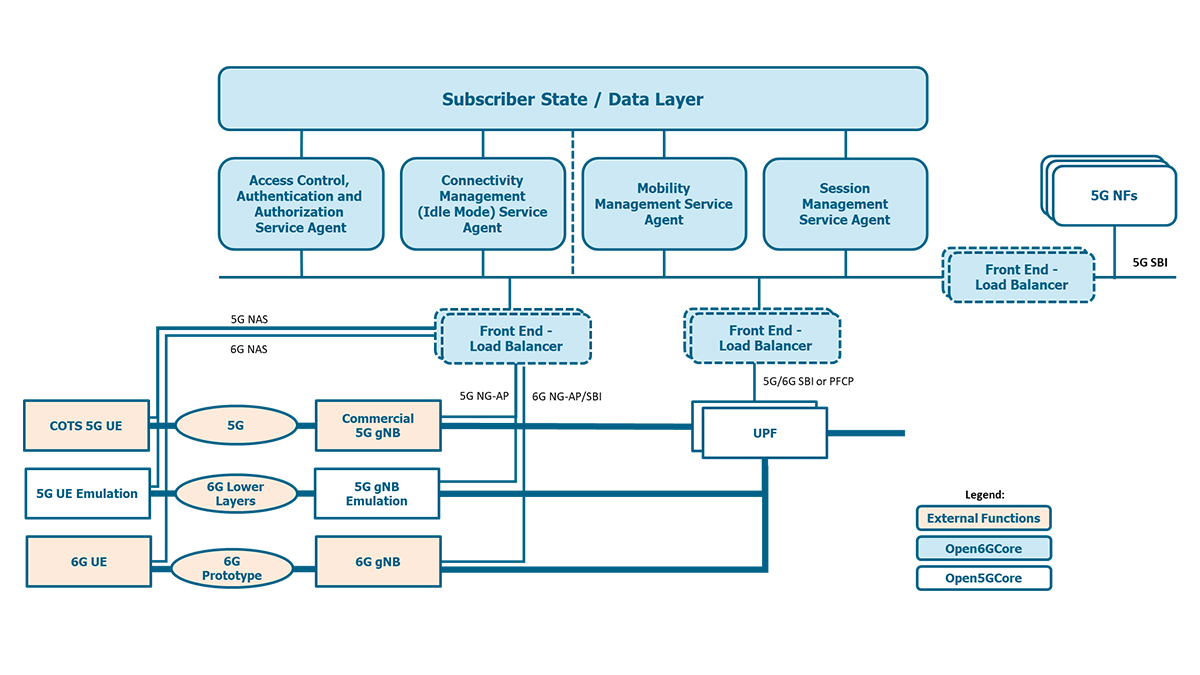Overview
- 100% cloud native
- Simplified core network
- Highly scalable
- Minimal resources footprint
- Fully integrated with 5G RAN (for immediate practical demonstrations)
- Easy to interoperate with 5G SBA network functions (facilitating a gradual evolution)
- Easy customizable and adaptable to use cases
- Ideal for testbeds and future research beyond 5G and 6G
- Based on 20 years of experience in implementing toolkits addressing the R&D community
First 6G core network implementation
The Fraunhofer FOKUS Open6GCore toolkit is the world’s first practical design and implementation of a 6G core network, aligning 3GPP networks with modern IT industry software development best practices. Leveraging our expertise from 4G OpenEPC and 5G Open5GCore, we’ve developed a highly flexible and ultra-scalable architecture suited for various deployment models and use cases. Open6GCore supports massive workloads and integrates seamlessly with 5G NR base stations and user equipment, offering a 6G core implementation compatible with today’s 5G functions.
Open6GCore is a toolkit made by researchers done for research. Easiness of external software integration, extensive flexibility for appropriate deployments, experimentation control and understanding through extensive observability are at our heart, of course next to implementing the latest concepts advancing software and validating in real end-to-end environments.
With Version 2 Open6GCore supports all the basis 5G procedures, being a complete core network. Within two years of development, the Open6GCore became an equivalent to the other 5G core network bringing additionally simple to understand mechanisms for integrating new functionality and services as well as new mechanisms for easy configuration and control of testbeds.
Open6GCore accelerates research by facilitating knowledge transfer from Fraunhofer FOKUS to our customers. It provides a robust foundation for beyond 5G and 6G testbed deployments, trials, pilots, and the development of new standard-oriented features. This toolkit embodies our 6G core network vision, enabling rapid innovation, swift implementation, and effective evaluation of new concepts and use cases through easy to manage testbed environments.
Features
Open6GCore is the first 6G core network implementation designed to meet the demands of 6G testbeds customers as well as for FOKUS projects. Key features of Open6GCore version 2 include:
- Implementation of the organic 6G core network concept: software programs can morph their functionality to the available infrastructure and use case needsfunctional requirements
- Highly flexible architecture – a new separation of the core network functionality while maintaining the SBA model
- Ultra-scalable design – drastic stateless functionality split
- Cloud-native deployment – enabling native load balancing and distribution.
- Comprehensive implementation of basic 5G procedures: registration, connectivity service, mobility and session management
- SBA-to-RAN extension for a flexible RAN-Core interaction
- Integration with the Open5GCore high capacity UPF and with the UE and gNB emulations for comprehensive emulation environments.
Compatibility with 5G base stations and phones, supporting NAS [N1], NG-AP [N2], and PFCP [N4]
Open6GCore can run on standard hardware platforms, supporting cloud-native deployments, containers, virtual machines, or bare metal. The hardware requirements for a testbed setup depend on the expected functionality and performance of control and data planes. Open6GCore can scale from a Raspberry Pi to a full rack of servers.
Open6GCore includes a comprehensive set of observability tools for time series, events and logs enabling a deep understanding of the status of the environment as well as with its own properly dimensioned GUI for testbed management.
Highly customizable, Open6GCore can be tailored to specific use cases. The source code license option offers ultimate flexibility for easy customization and prototype development.and performance of control and data planes. Open6GCore can scale from a Raspberry Pi to a full rack of servers.


